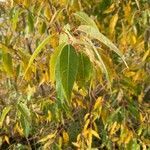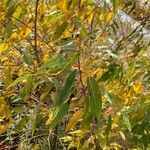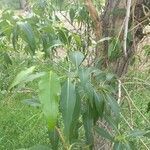Shrub or tree 3–20 m, with 1–4 often leaning trunks to 4 dm thick, the bark fissured; lvs and twigs a little hairy at the very beginning, but soon glabrous; twigs yellowish to reddish-brown, tending to droop; buds sharp-pointed, the short (2–5 mm) scale with free, overlapping margins; stipules typically minute and caducous or obsolete, rarely well developed; lvs thin, lanceolate to lance-ovate, 5–10(–15) × 1–3.5 cm, 3–6 times as long as wide, abruptly long-acuminate, closely serrate, yellowish-green above, strongly glaucous and minutely areolate beneath; petioles 6–20 mm, often twisted, with or without small glands at the end; catkins with the lvs, linear, lax, the staminate ones 4–7 cm, the pistillate becoming 5–20 cm; scales yellowish, villous especially within, deciduous; stamens 3–7, typically 5; fr lanceolate, 4–7 mm, smooth; pedicels 1.5–3 mm; style 0.2–0.4 mm; 2n=38. Floodplains and other moist or wet low places; Vt., N.H., ne. N.Y. and adj. Que., w. to se. B.C., and s. to Pa., Ky., Ark., and Ariz. An apparent hybrid with no. 3 [Salix nigra Marshall] is S. ×glatfelteri C. K. Schneid.




